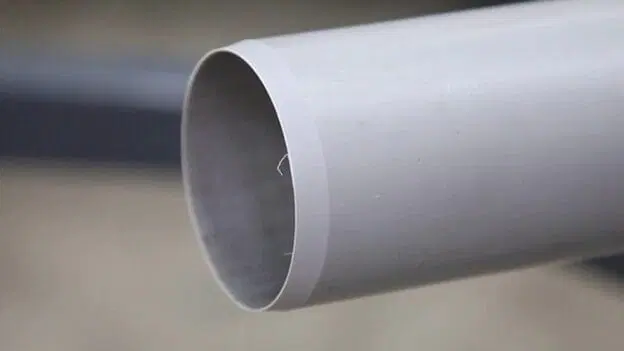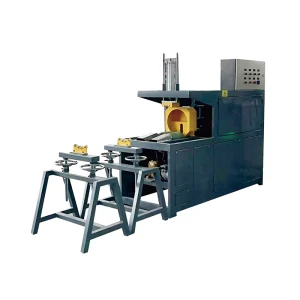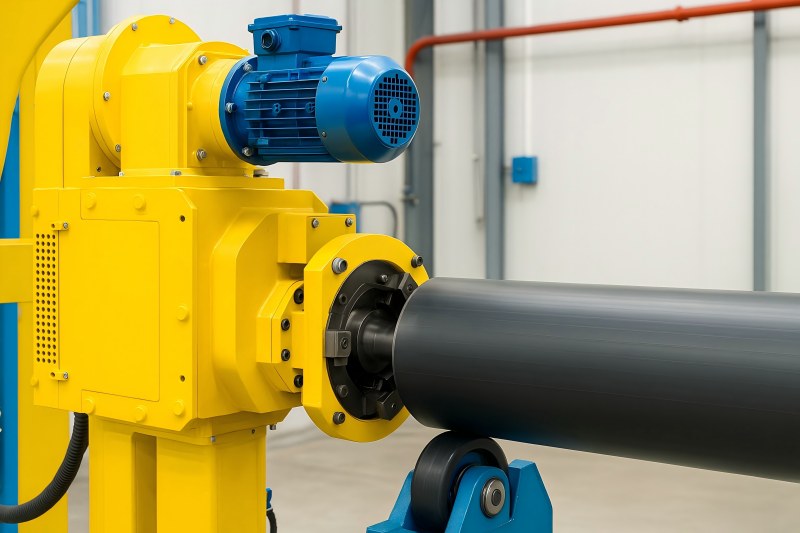In modern plastic pipe manufacturing, high-speed extrusion lines are designed to maximize throughput while maintaining product quality. However, as extrusion speeds increase, downstream processes—such as cutting, belling, and chamfering—must keep pace to avoid bottlenecks. Chamfering machines play a critical role in preparing pipe ends for socketing, joining, or sealing, but their integration into fast production lines requires careful planning.
For manufacturers, integrating chamfering machines effectively is not just about placing an additional machine after the cutter. It involves synchronizing speeds, optimizing machine layout, ensuring dimensional accuracy, and maintaining stable automated workflows. This article explores the technical considerations, benefits, and best practices for integrating chamfering machines into high-speed extrusion lines, including sample layout tables to guide decision-making.
Chamfering Machines in Extrusion Lines
Chamfering machines bevel pipe ends, enabling easier socketing and secure jointing. They ensure that the pipe end enters the belling socket smoothly and fits precisely with sealing rings or gaskets. This operation is especially crucial for PVC, PP, and PE pipes used in water supply, drainage, and conduit systems.
In a typical high-speed extrusion line, the process flow is as follows:
- Extruder: Melts and pushes plastic through a die.
- Vacuum calibration & cooling tanks: Shape and solidify the pipe.
- Haul-off unit: Moves the pipe steadily through the line at controlled speed.
- Cutter: Cuts the pipe to length.
- Chamfering machine: Processes the pipe ends for jointing.
- Belling machine (optional): Expands the pipe end to form a socket.
Integrating the chamfering process seamlessly between the cutting and belling stages ensures continuous, high-precision production.

Integration Objectives
The primary goals of integrating chamfering machines into high-speed extrusion lines include:
- Maintaining line speed without manual intervention or slowing down.
- Synchronizing control signals between cutter and chamfering units.
- Automating pipe transfer to minimize downtime.
- Ensuring chamfer accuracy at high production speeds.
- Reducing labor costs through inline automation.
- Improving downstream quality, minimizing socketing defects.
When done well, integration results in significant productivity gains, improved consistency, and reduced scrap.
Key Integration Considerations
Successful integration requires balancing mechanical layout, control systems, and operational logistics. Below are the most critical factors.
Production Speed Synchronization
High-speed extrusion lines often operate at speeds exceeding 10–25 m/min, depending on pipe size. Chamfering machines must match this speed to avoid backup or gaps between pipes.
- Inline chamfering machines are designed to work continuously in sync with the haul-off and cutter.
- Offline chamfering machines require pipe transfer after cutting, which can create delays and require buffering systems.
For high-speed operations, inline integration is usually preferred.
Automation and Control Interface
Chamfering machines must communicate with the extrusion line’s PLC (Programmable Logic Controller). Key signals include:
- Start/stop synchronization with the cutter
- Pipe position sensing
- Cycle completion confirmation before the next pipe arrives
- Emergency stop integration
Modern chamfering units come equipped with servo drives and encoders that allow precise positioning and rapid cycle times.
Mechanical Layout and Space Allocation
Sufficient space must be allocated for the chamfering unit and pipe transfer system. Common integration layouts include:
- Inline after the cutter with a transfer conveyor or automatic centering device.
- Rotary tables or V-block supports to stabilize pipes during chamfering.
- Dust extraction systems to maintain cleanliness and prevent buildup.
Pipe Handling and Stability
High-speed pipe transfer requires robust support systems:
- Automatic infeed rollers or conveyors align pipes as they exit the cutter.
- Clamping mechanisms secure the pipe during chamfering to prevent vibration.
- Automatic ejection systems move chamfered pipes to the next stage smoothly.

Inline vs. Offline Chamfering: A Comparison
The choice between inline and offline integration depends on production scale, line speed, and product range.
| Parameter | Inline Chamfering | Offline Chamfering |
| Speed Compatibility | Matches extrusion line speed | Independent of line speed |
| Automation Level | High, with synchronized controls | Moderate to high (may need buffers) |
| Labor Requirement | Minimal | More operators may be needed |
| Space Requirement | Compact inline layout | Requires separate buffer area |
| Product Consistency | Very high | Depends on transfer accuracy |
| Best For | High-speed, continuous production | Flexible, mixed-size, or low-speed operations |
Integration Process Step by Step
Below is a structured approach to integrating a chamfering machine into an existing or new high-speed extrusion line.
Step 1: Assess Line Specifications
Determine extrusion speed, pipe sizes, and cut lengths.
Check PLC communication protocols of existing equipment.
Evaluate space availability downstream of the cutter.
Step 2: Select Compatible Chamfering Machine
- Choose machine based on pipe diameter range, cycle time, and automation level.
- Inline chamfering machines should have servo-driven heads for precise control at high speeds.
Step 3: Design Mechanical Layout
- Plan pipe transfer path from cutter to chamferer.
- Include conveyors, rollers, or centering guides.
- Position dust extraction ducts.
Step 4: Integrate Control System
- Establish PLC communication between cutter and chamferer.
- Set up sensors for pipe detection.
- Program cycle start, stop, and error handling sequences.
Step 5: Trial Run and Adjustment
- Run line at low speed to fine-tune timing.
- Check chamfer accuracy, pipe alignment, and cycle consistency.
- Increase speed gradually to match full extrusion speed.
Step 6: Optimize for Continuous Operation
- Fine-tune chamfer depth and feed rate.
- Adjust conveyor speed synchronization.
- Set up maintenance and cleaning schedules.
Technical Parameters to Match
Proper integration depends on aligning technical parameters between extrusion, cutting, and chamfering. A sample parameter table is shown below:
| Parameter | Extrusion Line | Chamfering Machine | Required Match |
| Line Speed (m/min) | 10–25 | ≥ Line speed | Must match or exceed |
| Pipe Diameter (mm) | 50–400 | Same or wider range | Full compatibility required |
| Chamfer Cycle Time (s) | N/A | ≤ Cutter cycle time | No bottleneck allowed |
| Communication Protocol | PLC / Modbus / Profinet | Compatible interface | Seamless signal exchange |
| Dust Extraction Capacity (m³/h) | N/A | ≥ Machine spec | Must handle continuous operation |
Benefits of Proper Integration
Increased Throughput
By eliminating manual transfer steps, integrated chamfering systems keep pace with extrusion speeds, significantly increasing daily output.
Improved Quality Consistency
Automated chamfering ensures uniform bevel angles and clean edges, reducing socketing errors and improving joint sealing.
Labor and Cost Savings
Reduced manual handling minimizes operator intervention, allowing staff to focus on quality control and line supervision.
Cleaner Production Environment
Integrated dust extraction systems remove chamfer debris continuously, reducing downtime for cleaning and extending tool life.
Higher ROI on Extrusion Lines
Because the chamfering station no longer acts as a bottleneck, overall line efficiency improves, leading to better return on investment.
Common Challenges and Solutions
| Challenge | Cause | Solution |
| Misalignment between cutter and chamferer | Poor pipe transfer design | Use automatic centering guides and conveyors |
| Inconsistent chamfer depth | Unstable clamping or speed mismatch | Calibrate feed systems; upgrade to servo-driven chamfer heads |
| Excessive burrs or dust | Blunt tools or poor extraction | Regular tool maintenance; install efficient dust collectors |
| PLC communication delays | Incompatible protocols or slow signals | Upgrade PLC or use standardized industrial communication (e.g., Profinet) |
| Bottleneck at chamfering station | Slow cycle time relative to extrusion speed | Upgrade machine or adjust cutting cycle length |
Case Example: 110 mm PVC Pipe Line at 20 m/min
A pipe manufacturer producing 110 mm PVC pressure pipes at 20 m/min faced frequent slowdowns due to manual chamfering downstream of the cutter. Pipes were piling up, requiring two operators to transfer and chamfer pipes offline.
Solution Implemented:
- Installed an inline automatic chamfering machine with servo drives and dual chamfer heads.
- Integrated the machine with the extrusion line PLC using Modbus.
- Added roller conveyors and centering systems for pipe transfer.
- Installed a 5 kW dust extraction unit connected directly to the chamfering station.
Results:
- Chamfering cycle time reduced from 15 seconds per pipe to <6 seconds, fully matching line speed.
- Labor reduced by two operators per shift.
- Chamfer quality improved, leading to fewer rejected bell sockets.
- Overall line efficiency increased by 18%, boosting daily output significantly.
In high-speed plastic pipe production, integrating chamfering machines inline with the extrusion line is no longer optional—it’s essential for maximizing productivity, quality, and profitability. By focusing on synchronization, automation, and mechanical precision, manufacturers can achieve seamless downstream processing that keeps up with modern extrusion speeds.
A well-integrated chamfering system eliminates bottlenecks, enhances dimensional consistency, reduces labor dependency, and keeps production environments clean. With advancing extrusion technology, smart chamfering integration will increasingly distinguish top manufacturers in the market.

